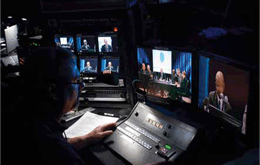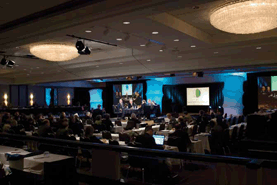Combating World Hunger Behind the Scenes

CTI Provides Support for World Agricultural Forum’s World Congress
CTI’s James Burgardt at work behind the stage.
The World Congress is a three-day event, with the Regional Congresses lasting one and one half to two days each. The Congress and Regional Congresses, over the last ten years, have attracted participation from 110 countries. This year the World Congress, held in the Hilton St. Louis at the Ballpark, attracted about 300 participants. Conference Technologies, Inc. (CTI) set up sound, recording, and projection systems in the Hilton ballroom, sound feeds in a press and media room, and computer equipment in the pressroom and registration area. CTI partnered with St. Louis-based Chi-Chi, LLC to produce the show, with Chi-Chi handing meeting planning services and CTI providing technology and staging.
- Setting Up The Main Events
- According to Greg Smith, director of the St. Louis Rental Department for CTI, meticulous planning was the key to making the World Congress come off flawlessly. “In a high-priority event, our rule of thumb is to double up all of the main components to be ready for any contingency,” he explains.
For the Hilton ballroom, Smith and his crew built a set with a podium, 9- x 12-foot Draper Cinefold rear projection screens to its right and left, and a 6- x 8-foot Cinefold rear screen positioned directly behind the speaker. CTI used the main screens to alternate between magnified video images of the speaker and PowerPoint or video presentations. The 6- x 8-foot screen carried a WAF logo to serve as a backdrop for the audience and the cameras.
Instead of three projectors to serve these three screens, CTI used six, with one projector on each screen designated as the primary unit and one as a backup. “It’s actually very rare that we’ll have a projector fail during a presentation,” Smith says, “but if it happens, all we need to do is throw a switch and the backup comes online.” CTI technicians thus set up four 10,000-lumen Christie projectors to serve the left and right screens and two 8000-lumen Christies to serve the center screen with the WAF logo.
In the same way, CTI technicians tied two laptop computers into the switching system, each loaded with the speaker’s presentation, and used two more for the logo on the center screen. They also doubled most of the sound system components. If a laptop, a microphone, amplifier, or even one of the loudspeakers had an issue, they could switch it out immediately.

The main stage during a roundtable discussion at the World Congress event in St. Louis in 2009. The left and right screens were used for IMAG and the center screen held the WAF logo.
A daily selection of the top stories for AV integrators, resellers and consultants. Sign up below.
CTI Wichita rental manager James Burgardt designed the video system used at the event. “We had three camera operators focused on the speakers, each using a Sony DXC-D35 from center, left, and right positions,” Burgardt says. “Backup wasn’t a major concern with the cameras, although we did have a fourth camera with us. But this setup gave us some really great shots across the tables, to the point where I heard one of the Forum people saying, ‘Wow, look at that.’”
WAF used this main stage set for single-speaker presentations, including a podium with two Shure MX418 gooseneck microphones and a confidence monitor setup using a 50-inch plasma display. James Bolger, the former president of New Zealand who is serving as the organization’s chairman, was the keynote speaker. CTI also set up a separate area in front of the main stage to be used for roundtable discussions, with tables and Shure SM58 microphones for up to eight participants. “We simply switched the lighting and sound to the appropriate area and focused our cameras on the person or people speaking,” Smith says.
Moldthan explains that the Congresses are very interactive: “We do have a few keynote speakers, but predominantly what we do is facilitate discussions between leaders in their fields, and then open it up to the audience for additional dialog.” For that reason, CTI also provided two hand-held Shure SLX wireless mics that WAF staff brought to audience members who wanted to ask a question or make a comment.
Smith says one small challenge in this ballroom was the ceiling height, which did not allow him to use the 12-inch lighting truss CTI would normally bring to this type of event. “Instead we hung horizontal lighting bars from the rigging points in the ceiling, which gave us some additional clearance.” CTI used 12 ETC Source 4 Lekos plus four Martin Mac 250 Krypton intelligent fixtures across the back of the stage to add some interesting color effects. “It worked out extremely well,” he says.
For loudspeakers, CTI positioned six Meyer M’elodie cabinets around the edge of the stage plus two JBL EON 10 G2 powered speakers set up on stands in the back of the room, all controlled by a Galileo 616AES management system.
CTI technicians set up a control area behind the main stage, with a Whole Hog lighting board, Midas Verona audio console, and a Panasonic AV mixer to switch between cameras, laptops, a JVC DVD player, and the projectors. Burgardt says CTI recorded all of the presentations on a Pioneer DVD recorder, and made MP3 audio recordings as well, which WAF immediately posted to their website. During breaks, one of the crew used a Canon XL2 camcorder to interview speakers and audience members in the hall and lobby areas. “We expect to post much of this video to our website,” Moldthan says, “and we have sent digital audio from the entire conference to all of the participants.”

WAF used this main stage set for singlespeaker presentations, including a podium with two Shure MX418 gooseneck microphones and a confidence monitor setup using a 50-inch plasma display.
Press and Media Room
In addition to the presentation room, CTI set up a media room with an area for interviews plus computers, network connections, printers, and a copier and fax machine for the press to use. They also supplied the computers and printers for the show’s registration area and AV for a food service area.
For the interview room, CTI set up video lighting using ETC fresnels and a 24-channel press bridge, or “media feed,” from Opamp Labs. “The media feed allows us to give clean audio to various crews without having to have a thousand microphones in the face of the person being interviewed,” Smith explains. He says CNN, MSNBC, the St. Louis Fox affiliate, KTVI, and St. Louis-based KMOV News sent crews to the Congress.
One advantage CTI brings to a show like this is the ability to bring in planners and technicians from up to seven branch offices. “This was actually a joint venture between our St. Louis and Wichita rental staffs,” Smith says. For this show, he brought in a crew of 25 for set up and strike and held 12 at the show site for system operations. All were CTI employees.
The AVNetwork staff are storytellers focused on the professional audiovisual and technology industry. Their mission is to keep readers up-to-date on the latest AV/IT industry and product news, emerging trends, and inspiring installations.
